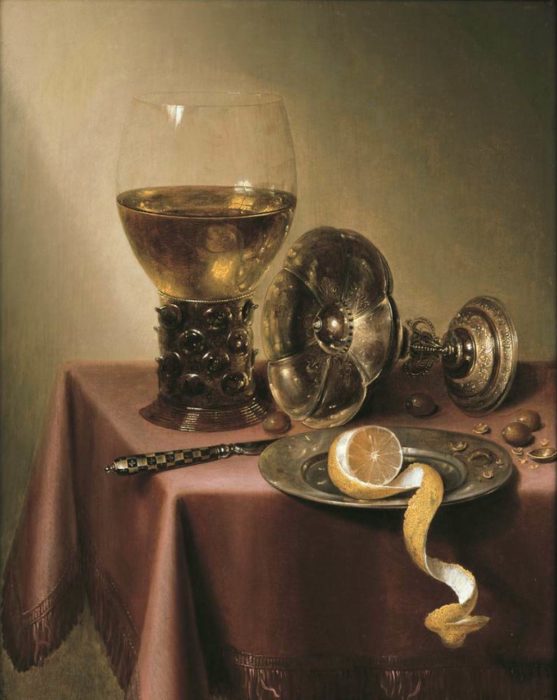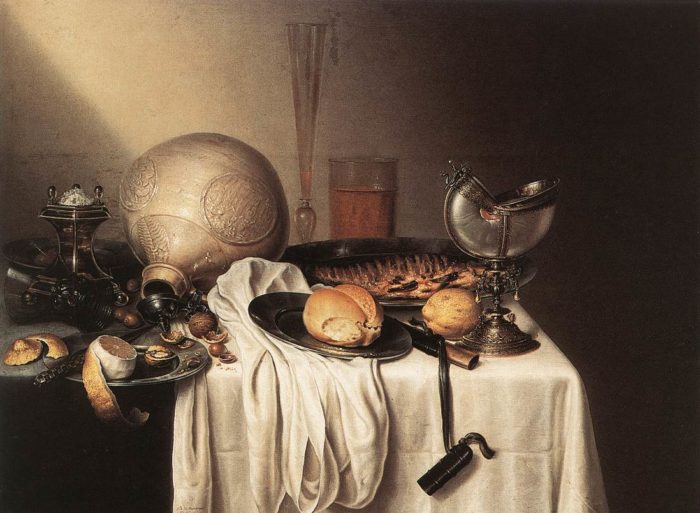Maerten Boelema (1611–1664)
Click on the images to find out more
Maerten Boelema was born in 1611 in Leeuwarden, the capital of the Friesland region, in the northern Netherlands. He was the third child of Dr Martinus Boelema and his second wife, Evertien Tiaertsdr. Boulema’s early life is little documented and it is not known whether he had any training in his native city. In 1642 he went to Haarlem to study with Willem Claesz Heda (1596/97-1680) one of the most accomplished Dutch still-life painters. In Haarlem, Boelema was fully immersed in the local, vibrant artistic scene devoted to the creation and production of still-life paintings. More precisely, Heda devoted himself exclusively to the breakfast genre (ontbijtjes) of still life painting, which emerged around 1610. This style is characterised by sombre, monochromatic colours and usually depicts a careful but simple assortment of foods, generally breakfasts, or a light meal which could be taken at any time of the day.
Boelema received his training alongside Heda’s son Gerret Willemsz Heda (1625-1649), who, like his father, painted meticulously executed still-lifes. He and Boelema shared a particular interest in the depiction of hams, tazzas (a decorated goblet) and rummers (a type of large and studded drinking glass). Within this milieu was also Pieter Claesz (1597-1660) who was similarly responsible for the development of this so-called monochromatic style of still-life in Haarlem in the 1630s and 1640s. This style depicts banquet scenes, characterised by a simple and harmonious arrangement of familiar foods such as ham, cheese and oysters and glasses of wine or beer on wooden tabletops, painted in a limited range of colour and tone. Boelema’s only dated works are confined to the years when he was learning and working in Heda’s studio. During this two year period from 1642 to 1644, he made about twenty still lifes, including paintings with banquets and breakfast foods. Throughout this time, his still-life scenes encompassed a similar range of subjects and styles to those favoured by his master.
After the apprenticeship, Boelema returned to the northern Netherlands developing a more personal style, focusing on a heterogeneous selection of objects and using subtle contrasts of light and shadow to differentiate his painting from that of the Haarlem masters. He liberated his art from earlier compositional ideas turning to more balanced and unified compositions, with a lower viewpoint, lighter palette and tactile effects. Boelema’s oeuvre consists of elegant still-lifes decorated with silver vessels, porcelain cups, dishes and precious glasses, usually set on a crumpled cloth and with a light background. Some of his pictures are signed but few are dated. Cornelis Kruys (1619-1660), a Dutch seventeenth century still-life painter, was Maerten’s contemporary and was himself influenced by his painting. Boelema was believed to have died around 1664.
Bibliography
Bakker, Piet. Gezicht op Leeuwarden: schilders in Friesland en de markt voor schilderijen in de Gouden Eeuw. PhD Dissertation, University of Amsterdam, Amsterdam, 2008.
Willingen, Adriaan van der and Meijer Fred. A Dictionary of Dutch and Flemish still-life painters working in oils 1525-1725, Leiden, 2003, 40.
Lorenzelli, Jacopo and Ligenbauer, Eckard. The Lure of Still Life. Bergamo, 1995.
Vroom, Nicolaas Rudolph Alexander. A Modest Message as Intimated by the Painters of the “Monochrome Banketje”. Schiedam, 1980.
Wassenbergh, Abraham. ‘Een vroeg stilleven van Maerten Boelema de Stomme’, De Vrije Fries, 46, 1964, 110–204.


